
Waddy Butler Wood
Encyclopedia
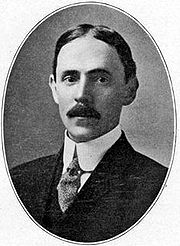
United States
The United States of America is a federal constitutional republic comprising fifty states and a federal district...
architect
Architect
An architect is a person trained in the planning, design and oversight of the construction of buildings. To practice architecture means to offer or render services in connection with the design and construction of a building, or group of buildings and the space within the site surrounding the...
of the early 20th century and resident of Washington, D.C.
Washington, D.C.
Washington, D.C., formally the District of Columbia and commonly referred to as Washington, "the District", or simply D.C., is the capital of the United States. On July 16, 1790, the United States Congress approved the creation of a permanent national capital as permitted by the U.S. Constitution....
Although Wood designed and remodeled numerous private residences, his reputation rested primarily on his larger commissions, such as banks, commercial offices, and government buildings. His most famous works include the Woodrow Wilson House and the Main Interior Building
Main Interior Building
The Main Interior Building, also known as the Stewart Lee Udall Department of the Interior Building, located in Washington, D.C., is the headquarters of the United States Department of the Interior....
.
Early life and education
Waddy Wood was born in St. LouisSt. Louis, Missouri
St. Louis is an independent city on the eastern border of Missouri, United States. With a population of 319,294, it was the 58th-largest U.S. city at the 2010 U.S. Census. The Greater St...
, Missouri
Missouri
Missouri is a US state located in the Midwestern United States, bordered by Iowa, Illinois, Kentucky, Tennessee, Arkansas, Oklahoma, Kansas and Nebraska. With a 2010 population of 5,988,927, Missouri is the 18th most populous state in the nation and the fifth most populous in the Midwest. It...
in 1869 to Captain Charles Wood, a Virginia
Virginia
The Commonwealth of Virginia , is a U.S. state on the Atlantic Coast of the Southern United States. Virginia is nicknamed the "Old Dominion" and sometimes the "Mother of Presidents" after the eight U.S. presidents born there...
n who had relocated west
Western United States
.The Western United States, commonly referred to as the American West or simply "the West," traditionally refers to the region comprising the westernmost states of the United States. Because the U.S. expanded westward after its founding, the meaning of the West has evolved over time...
to seek better opportunities. Shortly after his birth, the Woods returned to Virginia and settled in Albemarle County, Virginia. He grew up at "Nutwood," Ivy, Virginia near the Wood family state, "Spring Hill," the home of his grandfather, John Wood, Jr. until leaving to receive his advanced education at Virginia Polytechnic Institute.
Early career
In 1892 Wood began working as an architect in Washington, D.C.Washington, D.C.
Washington, D.C., formally the District of Columbia and commonly referred to as Washington, "the District", or simply D.C., is the capital of the United States. On July 16, 1790, the United States Congress approved the creation of a permanent national capital as permitted by the U.S. Constitution....
. His first important commissions were on two streetcar
Washington streetcars
For just under 100 years, between 1862 and 1962, streetcars in Washington, D.C. transported people across the city and region.The first streetcars in Washington D.C...
barns. The first was Metropolitan Railroad
Metropolitan Railroad
The Metropolitan Railroad was the second streetcar company to operate in Washington, D.C. It was incorporated and started operations in 1864, running from the Capitol to the War Department and along H Street NW in downtown. It added lines on 9th Street NW, on 4th Street SW/SE, along Connecticut...
's East Capitol Street Car Barn
East Capitol Street Car Barn
The East Capitol Car Barn, also known as The Car Barn Condominiums, is an historic building, located at 1400 East Capitol Street, Northeast, Washington, D.C., in the Capitol Hill neighborhood.-History:...
, which he helped to design with engineer A.N. Connett in 1896. The following year he designed the Georgetown Car Barn, then known as Union Station, for the Capital Traction Company
Capital Traction Company
The Capital Traction Company was the smaller of the two major street railway companies in Washington, D.C. in the early 20th Century. It was formed through a merger of the Rock Creek Railway and the Washington and Georgetown Railroad Company in 1895. The company ran streetcars from Georgetown;...
. During this time, Wood also designed several homes in what was then known as Kalorama Heights (now Adams Morgan).
Wood, Donn & Deming
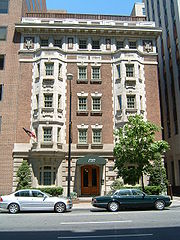
United States
The United States of America is a federal constitutional republic comprising fifty states and a federal district...
, including the expansion of the Portsmouth Naval Hospital
Naval Medical Center Portsmouth (Portsmouth, Virginia)
The Naval Medical Center Portsmouth , formerly Naval Hospital Portsmouth, is a United States Navy medical center in Portsmouth, Virginia, United States. It is the oldest continuously running hospital in the Navy medical system....
in Portsmouth, Virginia
Portsmouth, Virginia
Portsmouth is located in the Hampton Roads metropolitan area of the U.S. Commonwealth of Virginia. As of 2010, the city had a total population of 95,535.The Norfolk Naval Shipyard, often called the Norfolk Navy Yard, is a historic and active U.S...
. They also had a strong residential client base designing houses for prominent citizens such as Mrs. Phil Sheridan, General Charles Lane Fitzhugh
Charles Lane Fitzhugh
Charles Lane Fitzhugh was a brevet brigadier general in the Union Army during the American Civil War.-Military career:...
and Thomas Hopkins Gallaudet
Thomas Hopkins Gallaudet
Reverend Thomas Hopkins Gallaudet, LL.D., was a renowned American pioneer in the education of the Deaf. Along with Laurent Clerc and Mason Cogswell, he co-founded the first institution for the education of the Deaf in North America, and he became its first principal...
; as well as public residences such as the Bachelor Apartment House
Bachelor Apartment House
The Bachelor Apartment House is an historic structure located in the Northwest Quadrant of Washington, D.C. The architectural firm of Wood, Donn & Deming designed the building. It is believed to be the only example of luxury apartment building built for single men left in the city. It is also...
located near the White House
White House
The White House is the official residence and principal workplace of the president of the United States. Located at 1600 Pennsylvania Avenue NW in Washington, D.C., the house was designed by Irish-born James Hoban, and built between 1792 and 1800 of white-painted Aquia sandstone in the Neoclassical...
.
In 1906 Wood, Donn & Deming became the first Washington, D.C. architectural firm to design a bank high-rise in their city when they designed the Union Trust Building
Union Trust Building (Washington, D.C.)
The Union Trust Building, now home to the American Bar Association, is an historic building, located at 740 15th Street, Northwest, Washington, D.C....
, now home to an American Bar Association
American Bar Association
The American Bar Association , founded August 21, 1878, is a voluntary bar association of lawyers and law students, which is not specific to any jurisdiction in the United States. The ABA's most important stated activities are the setting of academic standards for law schools, and the formulation...
branch office and listed on the National Register of Historic Places
National Register of Historic Places
The National Register of Historic Places is the United States government's official list of districts, sites, buildings, structures, and objects deemed worthy of preservation...
. In the past, the city's largest banks had each retained nationally renowned architects while local architects were only chosen to design bank branches or remodel existing buildings. By choosing Wood's firm, Union Trust began a trend of the city's banks choosing local architects to design their buildings.
Wood's partnership with Donn and Deming is best known for the firm's work in 1907 on the Masonic temple
Masonic Temple
Masonic Temple is a term commonly used in Freemasonry with multiple but related meanings. It is used to describe an abstract spiritual goal, the conceptual ritualistic space formed when a Masonic Lodge meets, and the physical rooms and structures in which a Lodge meets...
located at the intersection of 13th Street, H Street
H Street (Washington, D.C.)
H Street is an east-west street in Washington, D.C.. It is also used as an alternate name for the Near Northeast neighborhood, as H Street is the neighborhood's main commercial strip.-History:...
, and New York Avenue
New York Avenue (Washington, D.C.)
New York Avenue is one of the diagonal avenues radiating from the White House in Washington, D.C. It is a major east-west route in the city's Northwest and Northeast quadrants and connects downtown with points east and north of the city via Cheverly, Maryland, the John Hanson Highway and the...
NW, which is now the National Museum of Women in the Arts
National Museum of Women in the Arts
The National Museum of Women in the Arts , located in Washington, D.C. is the only museum solely dedicated to celebrating women’s achievements in the visual, performing, and literary arts. NMWA was incorporated in 1981 by Wallace and Wilhelmina Holladay...
. The 69000 square feet (6,410.3 m²) building, a specimen of neo-Renaissance
Neo-Renaissance
Renaissance Revival is an all-encompassing designation that covers many 19th century architectural revival styles which were neither Grecian nor Gothic but which instead drew inspiration from a wide range of classicizing Italian modes...
and Renaissance Revival styles, was declared a Washington, D.C. Historic Landmark in 1984 and added to the National Register of Historic Places in 1987.
In addition to the Masonic lodge
Masonic Lodge
This article is about the Masonic term for a membership group. For buildings named Masonic Lodge, see Masonic Lodge A Masonic Lodge, often termed a Private Lodge or Constituent Lodge, is the basic organisation of Freemasonry...
hall, the building originally housed professional offices, the George Washington University
George Washington University
The George Washington University is a private, coeducational comprehensive university located in Washington, D.C. in the United States...
law library, and a movie theater. The exterior has never been altered substantially. As the Temple Association envisioned, the building's location at the tip of a wedge-shaped block provides an aesthetic buffer zone which "permits of no future building being erected sufficiently near to mar [the Temple's] monumental effect ... ."
Despite the successes of Wood, Donn and Deming, the firm was dissolved in 1912, and Wood opened his own practice.
Personal practice

Oscar Underwood
Oscar Wilder Underwood was an American politician.Underwood was born in Louisville, Kentucky, on May 6, 1862. He was the grandson of Joseph R. Underwood, a Kentucky Senator circa 1850. He attended the University of Virginia at Charlottesville...
home in Fairfax County - Woodlawn, a home originally designed by William Thornton
William Thornton
Dr. William Thornton was a British-American physician, inventor, painter and architect who designed the United States Capitol, an authentic polymath...
, which Wood had worked on previously during his association with Donn and Deming.
In the late 1910s, Wood was featured in an exhibition - at the famous Octagon
The Octagon House
The Octagon House, also known as the Colonel John Tayloe III House, is located at 1799 New York Avenue, Northwest in the Foggy Bottom neighborhood of Washington, D.C.-History:...
- of architectural drawings by Washington architects. In 1920 after the Octagon exhibit, Wood was selected to present drawings for the National Architectural Exhibition at the Corcoran Galleries
Corcoran Gallery of Art
The Corcoran Gallery of Art is the largest privately supported cultural institution in Washington, DC. The museum's main focus is American art. The permanent collection includes works by Rembrandt, Eugène Delacroix, Edgar Degas, Thomas Gainsborough, John Singer Sargent, Claude Monet, Pablo...
. The drawings selected were a mix of works between 1914 and 1920. A larger number were drawings of United States Housing Corporation buildings that he designed to house World War I workers. He also featured commercial buildings, such as the Shoreham Hotel and Commercial National Bank. His residential work featured at the exhibit included the Lawrence Lee Residence.
During the World War I
World War I
World War I , which was predominantly called the World War or the Great War from its occurrence until 1939, and the First World War or World War I thereafter, was a major war centred in Europe that began on 28 July 1914 and lasted until 11 November 1918...
period, Wood designed many temporary wartime buildings in Washington. He did not take a fee for the cost of designing the buildings and as a result was praised by Franklin D. Roosevelt
Franklin D. Roosevelt
Franklin Delano Roosevelt , also known by his initials, FDR, was the 32nd President of the United States and a central figure in world events during the mid-20th century, leading the United States during a time of worldwide economic crisis and world war...
, then a partner of the law firm Roosevelt and O’Connor of New York. Roosevelt and Wood first became associated when Wood designed a house
House
A house is a building or structure that has the ability to be occupied for dwelling by human beings or other creatures. The term house includes many kinds of different dwellings ranging from rudimentary huts of nomadic tribes to free standing individual structures...
for Roosevelt’s uncle, Frederic Delano
Frederic Adrian Delano
Frederic Adrian Delano was an American railroad president born in Hong Kong, China of the Delano family. He was the uncle of U.S. President Franklin Delano Roosevelt. Frederic Adrian Delano was Chairman of the Committee on the Regional Plan for New York and Its Environs, which released the...
. Wood was active in the Democratic Party
Democratic Party (United States)
The Democratic Party is one of two major contemporary political parties in the United States, along with the Republican Party. The party's socially liberal and progressive platform is largely considered center-left in the U.S. political spectrum. The party has the lengthiest record of continuous...
and their relationship continued after Roosevelt became President
President of the United States
The President of the United States of America is the head of state and head of government of the United States. The president leads the executive branch of the federal government and is the commander-in-chief of the United States Armed Forces....
. Wood was commissioned to design the inauguration
Inauguration
An inauguration is a formal ceremony to mark the beginning of a leader's term of office. An example is the ceremony in which the President of the United States officially takes the oath of office....
court of honor for President Roosevelt, as he had done for Roosevelt’s predecessor, Woodrow Wilson.
Wood was a proponent of the Colonial Revival style. In a 1922 article authored by Wood and published in Country Life magazine
Magazine
Magazines, periodicals, glossies or serials are publications, generally published on a regular schedule, containing a variety of articles. They are generally financed by advertising, by a purchase price, by pre-paid magazine subscriptions, or all three...
, he stated that architecture was “frozen history” and evidence of our past. His romantic
Romanticism
Romanticism was an artistic, literary and intellectual movement that originated in the second half of the 18th century in Europe, and gained strength in reaction to the Industrial Revolution...
view of buildings and architecture had its source in the days of the Colonial period
Colonial America
The colonial history of the United States covers the history from the start of European settlement and especially the history of the thirteen colonies of Britain until they declared independence in 1776. In the late 16th century, England, France, Spain and the Netherlands launched major...
, when the craftsman
Artisan
An artisan is a skilled manual worker who makes items that may be functional or strictly decorative, including furniture, clothing, jewellery, household items, and tools...
worked their buildings into an art form. His proponence of the Colonial Revival extends beyond the romantic view of the link between our past and present, but to its economic sensibilities of the early 20th century. He argued that the heavy articulation of the Craftsman style was much more costly than the Colonial Revival which is more delicate and simplified.
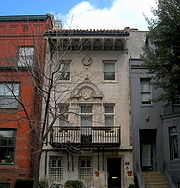
Though his government buildings are his most prominent, Wood was also recognized for his housing design
Design
Design as a noun informally refers to a plan or convention for the construction of an object or a system while “to design” refers to making this plan...
. His former partner, William I. Deming, was skilled in the restoration
Building restoration
Building restoration describes a particular treatment approach and philosophy within the field of architectural conservation. According the U.S...
of old homes, and during Wood’s association with Deming he was exposed to numerous renovations of historic houses in Virginia. He designed housing largely in Washington, DC, but also in Virginia for private clients, and some government clients. In addition, he designed school buildings for the Washington, DC school
School
A school is an institution designed for the teaching of students under the direction of teachers. Most countries have systems of formal education, which is commonly compulsory. In these systems, students progress through a series of schools...
system.
His greatest work is the Department of the Interior Headquarters Building in Washington, DC. Then Secretary of the Interior Harold Ickes
Harold L. Ickes
Harold LeClair Ickes was a United States administrator and politician. He served as United States Secretary of the Interior for 13 years, from 1933 to 1946, the longest tenure of anyone to hold the office, and the second longest serving Cabinet member in U.S. history next to James Wilson. Ickes...
personally selected Waddy Wood as architect and worked very closely with him to ensure comfort and efficiency in the innovative new building. He was so involved with the design and construction of the Interior building that when the building opened, it was referred to as "Ickes new home."
The Interior building is 7 stories with a basement (an additional floor between the 5th and 6th stories is devoted entirely to mechanical equipment). Above the central axis is a setback 8th story. The building is arranged into 6 east-west wings connected by a central north-south spine. This massing creates ten U-shaped courts, allowing each of the 2200 rooms an exterior exposure.
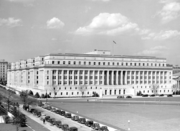
Sculpture
Sculpture is three-dimensional artwork created by shaping or combining hard materials—typically stone such as marble—or metal, glass, or wood. Softer materials can also be used, such as clay, textiles, plastics, polymers and softer metals...
. Six Native American
Indigenous peoples of the Americas
The indigenous peoples of the Americas are the pre-Columbian inhabitants of North and South America, their descendants and other ethnic groups who are identified with those peoples. Indigenous peoples are known in Canada as Aboriginal peoples, and in the United States as Native Americans...
artists painted more than 2200 square feet (204.4 m²) of murals.
The central corridor contains the Grand Staircase and has a checkered marble
Marble
Marble is a metamorphic rock composed of recrystallized carbonate minerals, most commonly calcite or dolomite.Geologists use the term "marble" to refer to metamorphosed limestone; however stonemasons use the term more broadly to encompass unmetamorphosed limestone.Marble is commonly used for...
floor, bronze
Bronze
Bronze is a metal alloy consisting primarily of copper, usually with tin as the main additive. It is hard and brittle, and it was particularly significant in antiquity, so much so that the Bronze Age was named after the metal...
railings and a coffered plaster ceiling. A pair of marble bas reliefs by Boris Gilbertson adorn the walls: one of moose
Moose
The moose or Eurasian elk is the largest extant species in the deer family. Moose are distinguished by the palmate antlers of the males; other members of the family have antlers with a dendritic configuration...
and the other of buffalo
American Bison
The American bison , also commonly known as the American buffalo, is a North American species of bison that once roamed the grasslands of North America in massive herds...
. The buffalo motif is found throughout the building including in the Departmental Seal and on the doorknobs of the Secretary of the Interior's Executive Suite. The Executive Suite has oak paneling with a marble fireplace. Besides offices, the building contains an auditorium
Auditorium
An auditorium is a room built to enable an audience to hear and watch performances at venues such as theatres. For movie theaters, the number of auditoriums is expressed as the number of screens.- Etymology :...
, museum
Museum
A museum is an institution that cares for a collection of artifacts and other objects of scientific, artistic, cultural, or historical importance and makes them available for public viewing through exhibits that may be permanent or temporary. Most large museums are located in major cities...
, Indian arts and crafts gift shop, library
Library
In a traditional sense, a library is a large collection of books, and can refer to the place in which the collection is housed. Today, the term can refer to any collection, including digital sources, resources, and services...
, post office
Post office
A post office is a facility forming part of a postal system for the posting, receipt, sorting, handling, transmission or delivery of mail.Post offices offer mail-related services such as post office boxes, postage and packaging supplies...
and gym
Gym
The word γυμνάσιον was used in Ancient Greece, that mean a locality for both physical and intellectual education of young men...
nasium-all part of the original design.
In addition to his work, Waddy Wood served as the president of the Washington Chapter of the American Institute of Architects
American Institute of Architects
The American Institute of Architects is a professional organization for architects in the United States. Headquartered in Washington, D.C., the AIA offers education, government advocacy, community redevelopment, and public outreach to support the architecture profession and improve its public image...
. In that capacity, he said in a 1928 speech "We will eventually build up a modern style of architecture based on evolution and not revolution, which has to rest, as all civilization does, on a foundation of precedent."
He died at his home near Warrenton, Virginia, January 25, 1944
Waddy Wood - Early
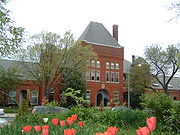
- 2121 Bancroft Place, NW, Washington, D.C.; 1895; Five-story brick town home, Wood's former residence
- East Capitol Street Car Barn, 1400 E. Capitol St., NE, Washington, D.C.; 1896, Romenesque design also known as the Metropolitan Car Barn 1974
- Georgetown Car Barn, 3600 M Street, NW, Washington, D.C.; 1897
- 1790-1796 Columbia Road, NW, Washington, D.C.; 1897-8, Wood lived in the house at 1796 Columbia Road from 1899 to 1900 and at 1794 Columbia Road from 1900 to 1902, 1790 has been razed
- 3100 Newark Street, NW, Washington, D.C.; 1897; introduced the Shingle style to Cleveland ParkCleveland ParkCleveland Park is a residential neighborhood in the Northwest quadrant of Washington, D.C.It is located at and bounded approximately by Rock Creek Park to the east, Wisconsin and Idaho Avenues to the west, Klingle and Woodley Roads to the south, and Rodman and Tilden Streets to the north...
- 3432 Newark Street, NW, Washington, D.C.; 1897; introduced the Mission Revival to Cleveland Park
- 2437-2455 18th Street, NW, Washington, D.C.; 1897, 2455 has been razed
- 2481-2483 18th Street, NW, Washington, D.C.; 1899
- Gunston Hall, 324 Vanderbilt Rd., Biltmore Forest, NC; 1900?, 1991
Wood, Donn & Deming

- Expansion of Portsmouth Naval Hospital, On Hospital Point at Washington and Crawford Sts., Portsmouth, VA; 1902, also known as Norfolk Naval Hospital, 1972
- Armstrong Manual Training School, Jct. of 1st and P Sts., NW, Washington, D.C.; 1902, 1996
- Chinese Legation, 2001 19th Street, NW, Washington, D.C; 1902; now condominiums
- Thomas P. Morgan Elementary School, 1773 California Street, NW, Washington, D.C.; 1902; the “Morgan” of Adams MorganAdams MorganAdams Morgan is a culturally diverse neighborhood in Northwest Washington, D.C., centered at the intersection of 18th Street and Columbia Road. Adams Morgan is considered the center of Washington's Hispanic immigrant community, and is a major night life area with many bars and restaurants,...
, razed prior to 1971 - Alice Pike Barney Studio House, 2306 Massachusetts Avenue, NW, Washington, D.C.; 1902; now the Embassy of LatviaLatviaLatvia , officially the Republic of Latvia , is a country in the Baltic region of Northern Europe. It is bordered to the north by Estonia , to the south by Lithuania , to the east by the Russian Federation , to the southeast by Belarus and shares maritime borders to the west with Sweden...
, 1995 - Rectory and school building at St. Patrick's Church, 619 Tenth Street, NW, Washington, D.C.; 1904 in English gothic style
- 1810-1820 19th Street, NW - includes the L. Ron Hubbard HouseL. Ron Hubbard HouseThe L. Ron Hubbard House, also known as the Original Founding Church of Scientology, is a historic house museum and former Scientology church located at 1812 19th Street, NW in the Dupont Circle neighborhood of Washington, D.C., United States. The home served as the residence of Scientology founder L...
- Enlarge and remodel Old Providence Hospital, Folger Square, SE, Washington, D.C.; 1904, razed 1964
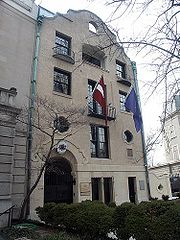
- Bachelor Apartment House (aka "The Bachelor"), 1737 H Street, NW, Washington, D.C.; 1905, 1978
- Douglas House, Washington, D.C.; 1905, built for Charles A. Douglas, razed in 1949
- Emmanuel Episcopal Church, US 250, Greenwood, VA; 1905-1915, 1982
- Geophysical Laboratory of the Carnegie Institution, 2801 Upton Street, NW, Washington, D.C.; 1906; now the Levine School of Music, 1994
- Capital Traction Company Car Barn, 4615 14th Street, NW, Washington DC; 1906, also known as the Decatur Street Car Barn, pending
- Union Trust Building, 740 15th St. NW, Washington, D.C.; 1907; Also known as First American Bank Building, 1984, currently the American Bar AssociationAmerican Bar AssociationThe American Bar Association , founded August 21, 1878, is a voluntary bar association of lawyers and law students, which is not specific to any jurisdiction in the United States. The ABA's most important stated activities are the setting of academic standards for law schools, and the formulation...
Building. - 1904 T Street NW, Washington, DC; 1907, annexed by Gunston Hall School in 1926, razed in 1965
- Masonic Temple, 1250 New York Avenue, NW, Washington, D.C.; 1907; now the National Museum of Women in the ArtsNational Museum of Women in the ArtsThe National Museum of Women in the Arts , located in Washington, D.C. is the only museum solely dedicated to celebrating women’s achievements in the visual, performing, and literary arts. NMWA was incorporated in 1981 by Wallace and Wilhelmina Holladay...
, 1987 - Enlarge and remodel the Faulkner House for Senator Thomas S. MartinThomas S. MartinThomas Staples Martin was an American lawyer and Democratic Party politician from Charlottesville, Virginia. He represented Virginia in the United States Senate for nearly twenty-five years....
, 2201 Old Ivy Rdoad, Charlottesville, VA; 1907, also known as Seymour, Montesano, Garallen or Old Ivy Inn, 1984 - 1845 Belmont Road, NW, Washington, DC; 1907, razed
- 2001 19th Street, NW, Washington, D.C.; 1908
- 1929-1933 19th Street, NW, Washington, D.C.; 1908, built for Charles H. Davidson (1929 & 1931) (1931 & 1933)
- Norfolk YMCA building, Norfolk, VA; 1908-1910
- Edgewood, Rt 231, Cash Corner, Keswick, VA; 1911, built for Ambassador George Barclay Rives, served as home for singer-songwriter Art GarfunkelArt GarfunkelArthur Ira "Art" Garfunkel is an American singer-songwriter, poet, and actor, best known as being a member of the folk duo Simon & Garfunkel...
and movie director Hugh Wilson
- Remodel Woodlawn Plantation, W of junction of U.S. 1 and Rte. 235, Fairfax, VA;?, 1970
- Emmanuel Church (Greenwood, Virginia)Emmanuel Church (Greenwood, Virginia)Emmanuel Church is a historic Episcopal church located at Greenwood in Albemarle County, Virginia. Emmanuel Episcopal Church is a parish church in the Episcopal Diocese of Virginia....
(1911-1913)
Waddy Wood - Late
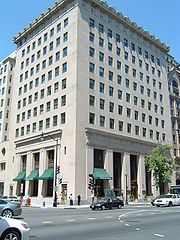
- Meadowbrook School, Leesburg, VA; 1912-13
- Providence Hospital, 1150 Varnum St., NE, Washington, D.C.; 1912-18
- Tucker House, 2320 S Street, NW, Washington, D.C.; 1913; now the Textile MuseumTextile MuseumThe Textile Museum is a private museum located in the Kalorama neighborhood of Northwest Washington, D.C., USA. The museum was founded by collector George Hewitt Myers in 1925 and is housed in two historic buildings: the Myers family home, designed by John Russell Pope, and an adjacent building...
, 1973 - Greystone, 2325 Porter Street, NW, Washington, D.C.; 1913
- Carnegie InstituteCarnegie Institution for ScienceThe Carnegie Institution for Science is an organization in the United States established to support scientific research....
, Dept. of Terrestrial Magnetism Laboratory, 5241 Broad Branch Road, NW, Washington, D.C.; 1913-14 - Washington Baseball Club, Washington, D.C.; 1914-21
- The Woodrow Wilson House; 2340 S Street, NW, Washington, D.C.; 1915, also known as the Fairbanks-Wilson House, 1966
- Bushfield Manor renovation and addition, 367 Club House Loop, Mount Holly, VA; 1916, 2004
- Shoreham Hotel, 2500 Calvert Street, NW, Washington, D.C.; 1916-21
- Council of National Defense building, Washington, D.C.; 1917-18
- Food Administration building, Washington, D.C.; 1918-19
- War Industries Board and War Trade Board buildings, Washington, D.C.; 1918-19
- United States Housing Corp., Washington, D.C.; 1918-21
- Commercial National Bank BuildingCommercial National Bank (Washington, D.C.)Commercial National Bank is an historic structure located in Downtown Washington, D.C. It was listed on the National Register of Historic Places in 1991.-History:...
, 700 14th St, NW, Washington, D.C.; 1919, 1991 - Martha Jefferson House, 1600 Gordon Ave, Charlottesville, VA; 1920-21, previously known as Ackley, then converted into a retirement home
- Thomas Balch Library, 208 W. Market St., Leesburg, VA; 1922
- Delano, Frederic A., residence, Washington, D.C.; 1922-28
- Blue Ridge Farm, Rt 637 & Rt 691, Greenwood, VA; 1923-1927, 1991
- All States Hotel for Women Government Employees, now William Mitchell Hall, an undergraduate residence hall at The George Washington University, 514 19th Street, NW, Washington, D.C.Washington, D.C.Washington, D.C., formally the District of Columbia and commonly referred to as Washington, "the District", or simply D.C., is the capital of the United States. On July 16, 1790, the United States Congress approved the creation of a permanent national capital as permitted by the U.S. Constitution....
; 1925. - The Victor Building Addition, 724-726 9th Street, NW, Washington, D.C.; 1925
- Brightwood Elementary School, 1300 Nicholson St., NW, Washington, D.C.; 1926
- Methodist Home for Aged, Washington, D.C.; 1926
- Chevy Chase Club and homes nearby, Chevy Chase, MD; 1926
- Southern Railway Building, 1500 K Street, NW, Washington, D.C.; 1928
- Handford MacNidor residence, Mason City, Iowa, 1929
- 1901 23rd Street, NW, Washington, D.C.; 1929; Neo-classical and Georgian Revival
- 1909 23rd Street, NW, Washington, D.C.; 1929; Neo-classical and Georgian Revival - built for his daughter.
- Fauquier County Hospital, Warrenton, VA; 1932
- The Diplomatic and Consular Officers Memorial - now in the State Department Building; 1933
- Department of the Interior headquarters building, 1849 C Street, NW, Washington, D.C.; 1934-38, 1986
- National Training School for Girls, 605 50th Street, NE Washington, D.C.; 1936; now the Nannie Helen BurroughsNannie Helen BurroughsNannie Helen Burroughs, was an African American educator, orator, religious leader, and businesswoman. She gained national recognition for her 1900 speech "How the Sisters Are Hindered from Helping," at the National Baptist Convention. She founded the National Training School for Women and Girls...
School

